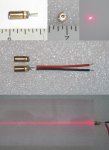It must be a DVD drive to get a red diode. Well, a CD drive will give you a red diode, it's just a band of red that won't be visible.
If you want a more powerful diode than ~1mw, yes, it must be a RW drive.
This means that you will (typically) have 2 diodes on the optical sled (except for stupid sleds that have a multi-wavelength, dual diode.. diode.. that has both 655nm DVD and 785nm or whatever [who cares] for CD) and will need to figure out which one is which. Typically, the diode itself or the molded heatsink will appear "beefier" on the DVD diode. Otherwise you just need to hook them up with a low current and check.
Just because you don't see anything doesn't mean that you're not powering the IR CD diode. Hopefully it's not collimated and you're not staring right at it.
These can be tested while they're still in the sled. Just rip off the final lens off the top of of the sled (the one you see if you look at the top of it, the bouncy one on the voice coil focusing mechanism), throw it away because it's useless, then put your leads on top of the solder joints connecting the ribbon that feeds the diode. Laser stuff will come out of the hole that was left under where you brutally ripped of the useless lens.
You can actually keep the diode in the sled and get a usable beam from it without needing to remount the diode in a module with a lens. You'll notice if you tested the diode in the sled that what comes out of the laser hole is a bunch of beams with one main bright beam in the center. That's because an annoying diffraction grating is in the beampath, just like the diffraction gratings that come with cheap laserpointers but instead of making a thumbs up figure or the word "slut" or whatever they do with those things, it just makes a bunch of stupid dim beams on each side of the main beam.
Your mission is to rip that diffraction grating out and throw it in the trash. For this, razor blades are your friend (also for cutting the adhesive that holds down the lenses and prisms, if you want to harvest them). It's a thin glass wafer usually mounted right on the output of the heatsink assembly holding the diode. It can be mistaken for a can window. Don't be fooled by it's lies. Now you have a single beam using the collimating lens that's mounted somewhere in the beampath.
Yay.
Since it's going to be DVD specs you're interested in you can forget about 48x and 52x since those numbers are for CD read/write performance and you don't care whatsoever about that.
It's going to be the DVD write/rewrite numbers that matter. So you'll be looking at 24X (I think that was the fastest rewrite speed produced for DVD/RW) or 16X (still quite powerful) or 8X (I think fastest on *laptop* DVD/RW drives, some have diodes that surprisingly can be driven to near 16/24x outputs likely with greatly reduced life, also often 3.8mm form factor open can diodes) or 4X (if it sucks).
300mw+ on 16X/24X drives if fed with 300-350ma of current
So it's 655nm and sure, that sucks, but that beam is tight like a tiger so the spot can actually look bright as hell.
Slower drive? Use less current.
Does it burn?
Yes, eventually.




